Thursday, February 26
Steve: Today we traveled 180 kilometers east toward the
South China Sea and Halong Bay for an overnight cruise. As we left the city,
it became quickly clear that the roads here (at least in the proximity of
Hanoi) are very good and that travel would be much different from what we
experienced in India. Many of the vehicles on the roads are modern cars or
SUV's, and people also seem to drive tamely (especially compared to India
or Morocco). Except for the occasional horse cart, the only thing sharing
the road with cars and trucks are bikes. There are bikes everywhere, and they
often ride 5 or 6 abreast right on the highway. 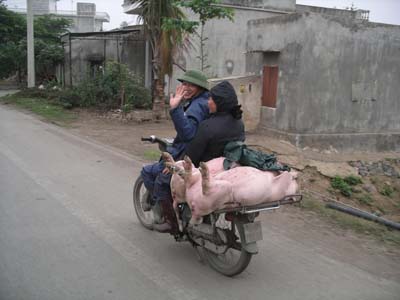
Today's most unusual sighting on the road was motorbikes carrying live pigs that were strapped and tied on their backs on their way to market. The driver of one of these bikes knew we were trying to take a picture, so he slowed down, turned around, smiled and waved! As we drove further, we saw many pigs being carried like this. Tan told us that they become immobile when placed on their backs (which is probably a good thing for the bike). The demand and price of pork has risen significantly here as a result of the bird flu.
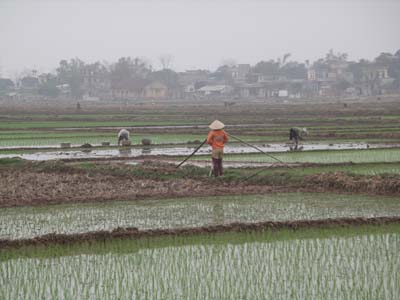 The
highway was lined with rice paddies, full of farmers who were plowing, flooding
and transplanting their fields. Fortunately for us, this happens to be one
of two 7-10 day periods that occur each year where the rice actually gets
planted. Eighty percent of all Vietnamese are farmers, and sixty percent of
these people farm rice. After Thailand, Vietnam
The
highway was lined with rice paddies, full of farmers who were plowing, flooding
and transplanting their fields. Fortunately for us, this happens to be one
of two 7-10 day periods that occur each year where the rice actually gets
planted. Eighty percent of all Vietnamese are farmers, and sixty percent of
these people farm rice. After Thailand, Vietnam 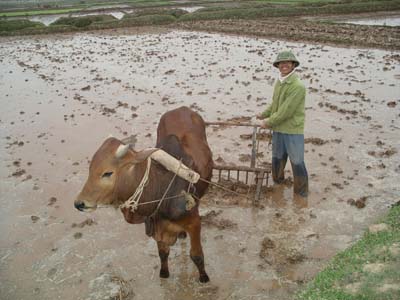 produces
more rice than any country in the world. In 1986, the government released
ownership of the country's farmland, and each family received an average of
½ hectares of land that they were free to farm as they wished. This
original allotment is effective for 10 or 15 years (depending on the prov
produces
more rice than any country in the world. In 1986, the government released
ownership of the country's farmland, and each family received an average of
½ hectares of land that they were free to farm as they wished. This
original allotment is effective for 10 or 15 years (depending on the prov ince),
after which time the land will be reallocated based on a new census.
ince),
after which time the land will be reallocated based on a new census.
The rice farming process is extremely laborious, and is almost all performed
by hand. First, last year's fields must be plowed and leveled - for this process,
5-6 families share a cow or water buffalo. Then the paddies must be flooded
with water. There are a series of canals that bring water into a general area,
but then the farmers must move the water by hand into their fields. An amazing
amount of water is neede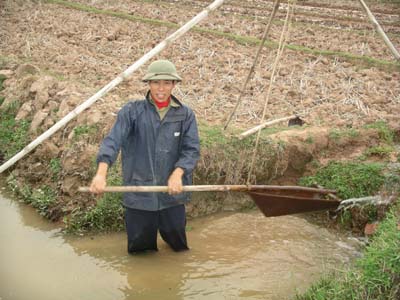 d,
and it was hard to imagine how much back-breaking work it must take to flood
the fields. We watched a man doing the work with a scoop attached to a wooden
tripod, and he smiled and laughed as we took pictures and Tan explained who
we were.
d,
and it was hard to imagine how much back-breaking work it must take to flood
the fields. We watched a man doing the work with a scoop attached to a wooden
tripod, and he smiled and laughed as we took pictures and Tan explained who
we were.
Interestingly, the first question this man asked was whether we were from Russia. Tan says this is a common question, because many people in the countryside have never seen any tourists except from Russia. From 1975 through 1989, Russian influence was heavy here and many Russian tourists regularly visited Vietnam. Since 1989, most people from the countryside have probably never met any foreigners, and so this man's natural assumption was that we were from Russia.
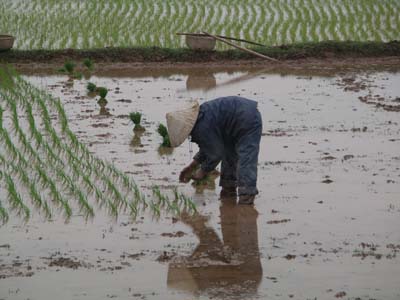 After
the paddies are flooded, rice plants are then transplanted into the mud in
rows. This work is generally performed by women who take 4 plants at a time
(they don't have time to count, but they seem to always grab exactly the right
number). After planting, the rice
After
the paddies are flooded, rice plants are then transplanted into the mud in
rows. This work is generally performed by women who take 4 plants at a time
(they don't have time to count, but they seem to always grab exactly the right
number). After planting, the rice 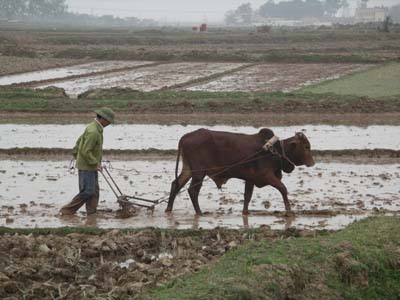 grows
very quickly and is ready for harvest in 2-3 months. We learned that ½
hectare produces an average of 6 tons of rice per year (that's a lot of rice),
and that each ton sells for approximately $180. That comes to just over $1,000
in revenue which generates an average $420 in income. Tan told us that most
families must find other ways to supplement their farming incomes, and that
some have turned to using their land for other more lucrative activities such
as farming turtles, frogs, fish, flowers and fruit.
grows
very quickly and is ready for harvest in 2-3 months. We learned that ½
hectare produces an average of 6 tons of rice per year (that's a lot of rice),
and that each ton sells for approximately $180. That comes to just over $1,000
in revenue which generates an average $420 in income. Tan told us that most
families must find other ways to supplement their farming incomes, and that
some have turned to using their land for other more lucrative activities such
as farming turtles, frogs, fish, flowers and fruit.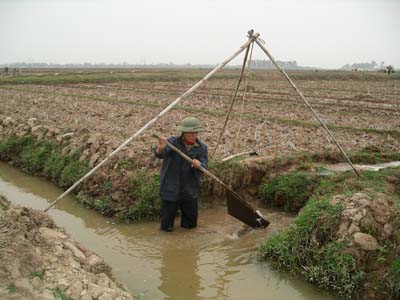
 It
was great to learn about the rice farming process, and we especially enjoyed
interacting with the farmers while they were doing their work. The people
we met were all friendly and full of smiles, and seemed amused that we'd want
to take pictures of them in action.
It
was great to learn about the rice farming process, and we especially enjoyed
interacting with the farmers while they were doing their work. The people
we met were all friendly and full of smiles, and seemed amused that we'd want
to take pictures of them in action.
After another 2 hours, we arrived at Halong Bay and boarded our Vietnamese
junk for an overnight cruise. It was very foggy and misty today, but we learned
that at this time of year there are very few sunny days. Similar to our cruise
on Doubtful Sound in New Zealand, the 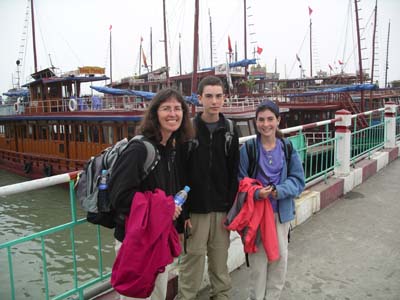 fog
created a very peaceful and somewhat mysterious effect on the water.
fog
created a very peaceful and somewhat mysterious effect on the water.
Halong Bay covers 1,500 square kilometers starting from the shore of Vietnam
and extending to the South China Sea. It contains dramatic limestone cliffs
that shoot directly from the water. Unlike Doubtful Sound, many of these cliffs
are small islands, creating a very beautiful effect as 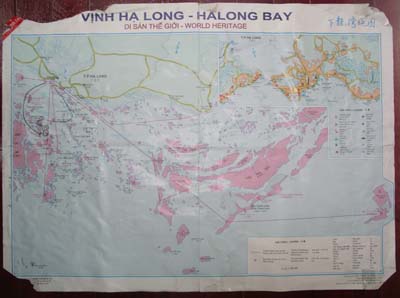 we
cruised through the bay on our boat. The rock formations of Halong Bay were
actually formed by a combination of volcanic activity and earthquakes.
we
cruised through the bay on our boat. The rock formations of Halong Bay were
actually formed by a combination of volcanic activity and earthquakes.
 Halong
Bay is also the home to several communities of floating homes. The people
of these homes are fishermen, and they spend their entire lives on the water,
stepping foot on the mainland only to sell fish and buy supplies. Many of
these floating homes are multiple generations old. Children, who are schooled
by teachers who come to these communities, usually chose to adopt the same
lifestyle as their parents.
Halong
Bay is also the home to several communities of floating homes. The people
of these homes are fishermen, and they spend their entire lives on the water,
stepping foot on the mainland only to sell fish and buy supplies. Many of
these floating homes are multiple generations old. Children, who are schooled
by teachers who come to these communities, usually chose to adopt the same
lifestyle as their parents.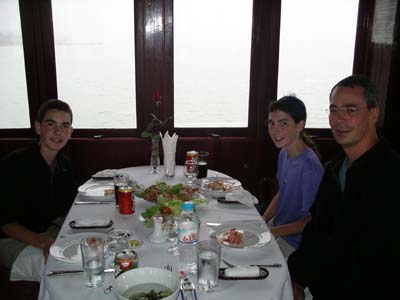
Our boat is large, and is meant to carry 15+ people in its 7 private cabins. The upstairs dining room contains a bar and 6 tables, each capable of seating 4 people. Tan told us that the Queen of Denmark recently stayed on this same boat, so we felt honored! Needless to say, we felt pretty funny having this boat all to ourselves. However, the quiet and privacy made for a very relaxing and enjoyable experience.
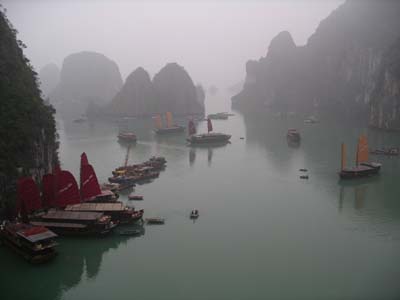 After
a wonderful seafood lunch (including fresh prawns, crabs, calamari and fish),
we began our cruise into Halong Bay. Soon we were weaving in and out of spectacular
islands and vertical cliffs, all shrouded in mist. There are over 3,000 islands
(1,969 are officially named and recognized by UNESCO) in Halong Bay, which
has been declared a World Heritage Site. We were amazed to learn that it would
take our boat a full 3 hours to motor through all of Halong
After
a wonderful seafood lunch (including fresh prawns, crabs, calamari and fish),
we began our cruise into Halong Bay. Soon we were weaving in and out of spectacular
islands and vertical cliffs, all shrouded in mist. There are over 3,000 islands
(1,969 are officially named and recognized by UNESCO) in Halong Bay, which
has been declared a World Heritage Site. We were amazed to learn that it would
take our boat a full 3 hours to motor through all of Halong 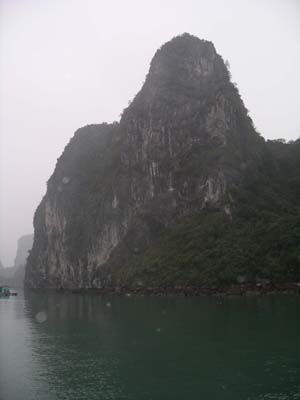 Bay's
rock formations if we wanted to reach the South China Sea.
Bay's
rock formations if we wanted to reach the South China Sea.
The water here is well protected and totally flat, creating a very peaceful
scene. One of our favorite sights were the local fishermen and residents of
the floating communities traveling throughout the bay in their small boats.
Even children row their own boats, and one girl and boy were particularly
cute in their small boat filled with fruit for sale. There are also several
floating fish markets where boats from the mainland come to buy fish from
the fishermen who return each afternoon from the sea. These boats also deliver
food and supplies to the families who live here. 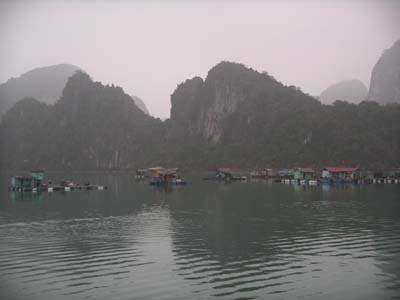
We learned that there are 5 separate floating communities of people who live
their entire lives here on Halong Bay. The people who live here are fishermen.
The man of the family spends his day fishing out at sea, while his wife maintains
the home and cooks food. Children are taught in small floating schools. Each
day when the man returns from fishing late in the afternoon, a boat from the
mainland meets him to buy fish and to deliver supplies to the family. 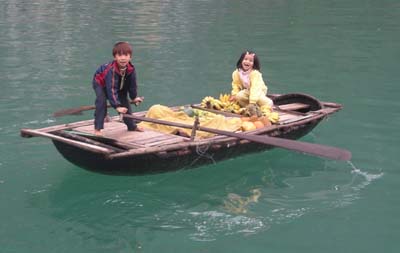 These
people never leave the water, and the homes here date back several generations.
What a different life this is…
These
people never leave the water, and the homes here date back several generations.
What a different life this is…
We made a couple of stops before anchoring for the night. First, we went
into a huge limestone cave, aptly called "Amazing Cave". 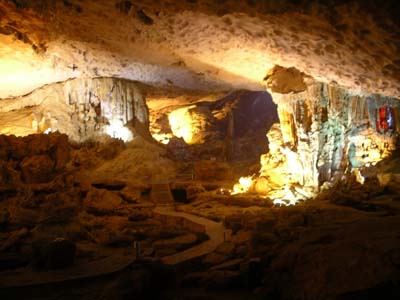 This
cave is huge and cavernous, and contains several stalagmites and stalactites.
Next we stopped at a sandy beach where we relaxed and took in the wonderful
views.
This
cave is huge and cavernous, and contains several stalagmites and stalactites.
Next we stopped at a sandy beach where we relaxed and took in the wonderful
views.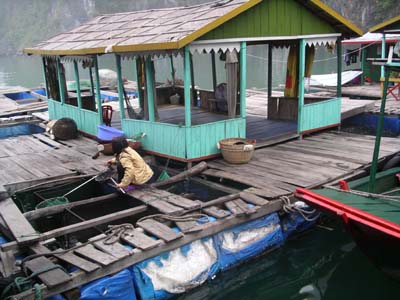
Dinner was another smorgasbord of fresh seafood, some of which we purchased at one of the local fish markets today. We had prawns, a type of crayfish, clams and fish - it was all wonderful, but was much more than we could eat.
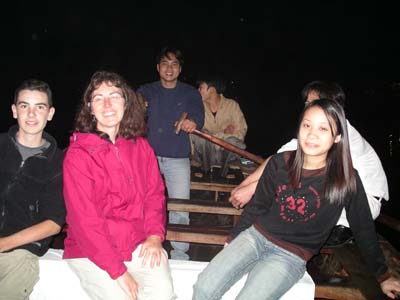 After
dinner, we tried our luck fishing for squid off the back of the boat. Bright
lights are shined in the water to attract the squid, and small lures hung
on bamboo poles are used to catch them. We didn't have luck with the squid,
but David and Katie had fun trying to hook minnows that swam near the lures.
After
dinner, we tried our luck fishing for squid off the back of the boat. Bright
lights are shined in the water to attract the squid, and small lures hung
on bamboo poles are used to catch them. We didn't have luck with the squid,
but David and Katie had fun trying to hook minnows that swam near the lures.
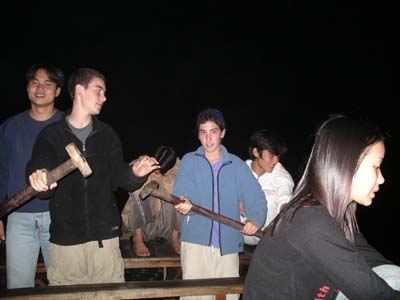
When it was clear that no squid were coming our way, we set out in a large
rowboat to visit a nearby fishing village (essentially a group of floating
homes that double as fish markets). Here we visited a family on their home,
and spent time (through translations done by Tan) talking with them about
their lives as fishermen. The home is made of bamboo poles with a series of
pens where 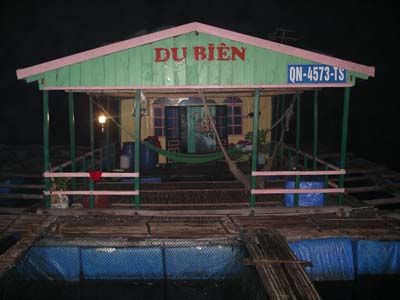 here
fish are kept. For living space, there are 2 open rooms and a covered outdoor
patio with hammocks. This is home for a husband, wife and their three children.
It was 10:30PM, and the children were up playing while the adults worked on
preparing the fishing nets for tomorrow. We learned that the fishermen leave
each day at
here
fish are kept. For living space, there are 2 open rooms and a covered outdoor
patio with hammocks. This is home for a husband, wife and their three children.
It was 10:30PM, and the children were up playing while the adults worked on
preparing the fishing nets for tomorrow. We learned that the fishermen leave
each day at 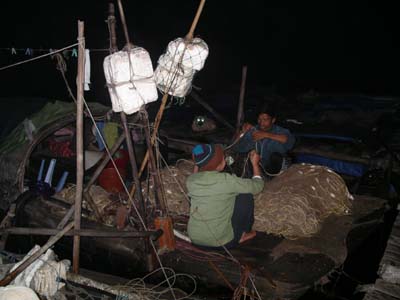 5:00AM
and motor for 3 hours before reaching their fishing grounds at sea. The small
boats each carry 2-3 people who manage the large nets that are drifted for
hours at a time. The fishermen told us that they use many different signs
to determine where the fish are, including currents and the smell of the
5:00AM
and motor for 3 hours before reaching their fishing grounds at sea. The small
boats each carry 2-3 people who manage the large nets that are drifted for
hours at a time. The fishermen told us that they use many different signs
to determine where the fish are, including currents and the smell of the  sea.
We were struck by how dependent these people are on these very simple boats
and tools for fishing.
sea.
We were struck by how dependent these people are on these very simple boats
and tools for fishing.
Visiting these people was a wonderful experience. We always get great satisfaction by meeting and speaking with people who live such different lives from our own…
Finally, after a long and very rewarding day, we retired in the comfort of our cabins and quickly fell asleep. Tomorrow we'll complete our exploration of Halong Bay and then drive back to Hanoi.
